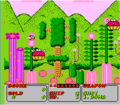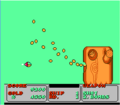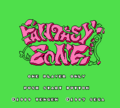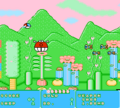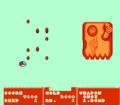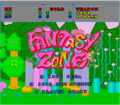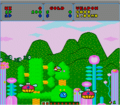Famicom[edit]


Developed by SunSoft and released in Japan on August 20, 1987. The Famicom's inability to display many colors at one time results in some odd color choices for the background which can make the enemies difficult to distinguish. Although the background disappears when the bosses arrive, it manages to keep all of the bosses intact, compared to the Sega Master System which changes two of them. For some reason, the status bar with your score, money, and weapons has been repositioned on the bottom of the screen. There are only 8 bases per stage instead of 10, and there is no color change to indicate how close the bases are to destruction. Flickering is very visible throughout the game. This version is the basis for the variation known as Fantasy Zone Neo Classic found on the PlayStation 2 version of Fantasy Zone Complete Collection.
-
Title screen
-
Plaleaf
-
First boss
MSX[edit]

Out of all the systems mentioned on this page, the MSX is the weakest technologically. Therefore, it shouldn't be too surprising to find that the MSX port of the game is the least faithful. Rather than using the Arcade version as the basis for this port, the Sega Master System is the inspiration. Many sprites are monochromatic in color, and the scrolling is choppy, as it is in many MSX games.
-
Title screen
-
Plaleaf
-
First boss
NES[edit]

For a variety of legal reasons, Tengen was unable to localize the SunSoft conversion of Sega's arcade game to Nintendo's platform. Not to mention the fact that by this time, Tengen was developing games without license from Nintendo. So Tengen went ahead and developed their own conversion of Fantasy Zone for the NES, making it one of the few NES games to share a title with a Famicom game, yet are entirely different programs (Tetris is another.) Like the Famicom version, the status screen is on the bottom as opposed to the top. The sprites are not as accurate to the arcade as the SunSoft Famicom version, but the colors are better in general, and many feel that the sound is better as well. However, there are only six bases per stage, and the 7 Way Shot has been reduced to a 5 Way Shot.
-
Title screen
-
Plaleaf
-
First boss
Nintendo 3DS[edit]
Developed by M2 and released in 2014.
PC-Engine (Turbo Grafx-16)[edit]


With more graphical power than the Famicom/NES or the Sega Mark III/Master System, the PC-Engine or Turbo Grafx-16 boasts the best looking of the downgraded ports of the game. Because the system does not possess as wide a range of colors as the arcade, many of the pastel colors are considerably darker in this version. Sound also suffers a little compared to the arcade version. Other than that, this version is very accurate to the arcade, featuring the status bar on top, a full 10 bases per stage, and color changing on the base to indicate remaining strength. Even the full background remains when the boss appears.
-
Title screen
-
Plaleaf
-
First boss
PlayStation 2[edit]

As part of Sega's "Sega Ages 2500" series for the PlayStation 2, the third volume was a remake of Fantasy Zone. There are three modes, "Normal," "Arcade" and "Challenge." Except for the graphics, the Arcade mode is as accurate to the original arcade game as possible. Instead of reproducing the graphics using 2D sprites, the game is completely recreated in 3D, using cel shaded models. The game was included in the Sega Classics Collection outside of Japan. For more information, see Sega Ages 2500 Vol. 3 Fantasy Zone. Sega later released the Fantasy Zone Complete Collection on the PlayStation 2 as volume 33 of Sega Ages 2500.
-
Title screen
-
Plaleaf
-
First boss
Sega Master System[edit]


This was the first cartridge that Sega produced for the 8-bit machines with 1 Megabit of memory, and was considered a premiere conversion when it was released in 1986, shortly after the arcade version. The color selection is quite vibrant, rivaling both the Famicom and NES conversions, but the bases are static and do not animate or show any sign of damage as they get hit. Only six bases are found per stage as opposed to the original 10. The background disappears when the bosses appear, and two of the bosses were so complex that they had to be changed to simpler designs. These new bosses can be seen at the end of Stage 4 and 6. There is also no radar to indicate the positions of the remaining bases.
-
Title screen
-
Plaleaf
-
First boss
Sega Mega Drive[edit]

Released in 2022 on the Mega Drive Mini 2, includes a beginner's mode.
Sega Saturn[edit]

Fantasy Zone was released by Sega for the Sega Saturn in 1997 as part of the Sega Ages label. It is possibly the most arcade accurate port developed by Sega, in that it neither takes away any features, nor does it add very many. It does contain one remixed song, the background music heard in the first stage, which is accompanied by a woman singing newly written lyrics. It also includes a few cheat codes to make small changes to the behavior. See the secrets page for more information.
-
Title screen
-
Plaleaf
-
First boss
Sharp X68000[edit]

The Sharp X68000 is a Japanese computer system that was known for having outstandingly arcade accurate ports, and Fantasy Zone is no exception. Upon its release, it was the most accurate conversion of the game available. In addition to being remarkably accurate, this version also contained an arrange mode where the basses drop the letters in the word "HARRIER" instead of coins. If you manage to collect the letters and spell "HARRIER" in each of the first seven levels, you will be taken to a secret stage known as "Dragon Land" which is decorated with a Space Harrier theme, and you must fight bosses from that game before proceeding to fight all of the bosses from Fantasy Zone again.
-
Title screen
-
Plaleaf
-
First boss
-
Dragon Land
Windows[edit]

Fantasy Zone was made commercially available for Windows in Japan through a software package entitled Sega Memorial Selection. It contained two other classic Sega games as well. While all three games are reportedly arcade accurate, it is rumored that the version of Fantasy Zone included in this package is based on the Sega Saturn version, and therefore many of the cheats provided for that version are available for Windows as well.
-
Title screen
-
Plaleaf
-
First boss


